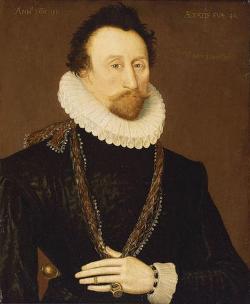|

William Adams the first Englishman in Japan:

 16th century English Sea Captian
16th century English Sea Captian
William Adams, the first Englishmen to arrive in
Japan, made landfall on April 19 th 1600 at Usaki in Bungo on the
island of Kyushu.
Adams had left Holland two years earlier for the
Dutch India Company in the company of five ships heading west to
South America, through the straights of Magellan and across the
Pacific Ocean. By the time the expedition reached Japan the attrition
rate of materiel and personnel was so great that only one ship remained
with 24 men aboard and most of them were in a sickly state of health.
The condition of the crew was so bleak that only nine of the remaining
twenty four were even able to walk. The ship "The Erasmus"
had left Rotterdam in June 1598 with 110 men aboard.
During the course of the voyage two of the expeditions
five ships had been taken captive, one by the Spanish, one by the
portuguese and another had been lost along with all personnel to
a storm while attempting to cross the Pacific. The fifth ship had
turned back at the Straights of Magellan and had arrived safely
back in Rotterdam.
The port where Adams ship cast anchor was occupied
by the Jesuits missionaries whom Francis Xavier had left under
Otomo Sorin's pledge for protection in 1552. The care of Adam's
crew and the restoration of their health fell to the Jesuits and
the priests also functioned as interpretors for the Japanese.
By the time Adams arrived in Japan the Portugese
had been trading in Kyushu for over fifty years and undoubtedly
had some political sway in the region. Due to the accusations of
some of the Portuguese in the region Adams came under suspicion
of being a pirate. The Dutch and English had been waging an ongoing
battle at sea with the Spanish and Portuguese in and around Europe
for supremacy at sea. Adams had been a commander of a ship in Drake's
fleet of ships in the conflict between England and the Spanish Armada
in 1588. This was a fact that Adams kept to himself however the
fact that he was English was information enough for the Portuguese
to be heavy handed with Adams and his crew. He and his crew were
jailed and news of their presence in Japan was sent to Tokogawa
Ieyasu in Osaka.
At the time of Adams arrival, Tokogawa Ieyasu had
just occupied Osaka Castle under the auspieces of being the primary
caretaker and advisor of the young Toyotomi Hideyori the apparent
heir to the Shogunate. The political shifts of power that would
bring Ieyasu to pre-eminence in Japan were just beginning to play
out. The first of these shifts was Ieyasu's move into Osaka Castle
with the excuse of undertaking an advisorary role to the young Hideyori
and his Mother Lady Yodo. This move by Ieyasu had stirred reactions
from the council of five, the political regents of Japan, and set
the stage for further confrontations between the members of Hideyori's
advisorary council.
Hideyori was still just a child of eight when Adams
arrived in Japan, and it was Ieyasu who was making the decisions
at Osaka Castle. Ieyasu confiscated the "Erasmus" and
all of its cargo and had the crew sent to Osaka from Bungo to be
jailed at Osaka Castle while he sorted out what was to be done with
them.
The cargo of the ship "Erasmus" was a
windfall of Dutch and English weaponry of the time. The ship was
of 400 ton class and had 26 cannon. The cargo had 550 matchlocks
, 5,000 cannon ball and 5,000 lbs of gun powder as well as chain-shot
and shrapnell. The ship itself had a figurehead which was described
as Eramus holding a book in his hand and was sometimes called the
"Charity". This windfall of weaponry and gunpowder was
probably used by Tokogawa Ieyasu at the Battle of Sekigahara.
At the time Adams arrived in Japan it had been
just over two years since the previous shogun, Toyotomi Hideyoshi,
had died. Hideyoshi had been a vassal to Oda Nobunaga and had gained
political preemminence and the power and strength to continue the
unification Japan. Since his death, the most powerful daimyo in
the land, men of noble birth and regents to the juvenile heir of
Hideyoshi, had continued their feuding and bids for absolute power.
Various factions had begun to form among Hideyoshi's five regents
so that the two most powerful contenders for the shogunate, Tokugawa
Ieyasu and Ishida Mitsunari were preparing to bring Eastern and
Western Japan into conflict and face each other for a final showdown.
Six months from the time of Adams arrival on the
morning of October 21, 1600 the transition of power from Toyotomi
Hideyoshi to Tokogawa Ieyasu would be determined at the Battle of
Sekigahara.
It was William Adams fate to become one of the
chief advisors to Ieyasu in his dealings with the European powers.

The basic plot for James C lavell's novel "Shogun"
is based on the history of William Adams in Japan.
The
life and times of St. Francis Xavier, 1512- 1552
Page: 1
Xavier
meets Otomo Sorin the King of Bungo,1550
Page: 2
William Adams arrives in Japan, 1600
Page: 3
The
Epic Journey of Hasekura Tsunenaga, 1613-1620
Page: 4
James I king of England (1603-1625) and his personal correspondence
with Tokugawa Ieyasu Shogun of Japan ( 1600-1616)
Page: 5
The life and times of Hosokawa Sansai.
(1564 -
1645)
Page 6
This Page was co-authored by Chester
Comstock in co-operation with Kanayama, For additional information
on Kanayama and his collection of Japanese Antiquities from the
16th and 17th Centuries see:
Kanayama Discusses Sukashi Tsuba
Chester Comstock is the Publisher and Editor of Artsales.com and
the founder and owner of
Comstock Sculpture Studio.
|
